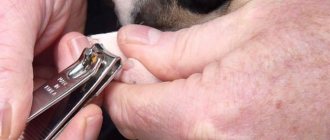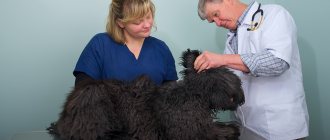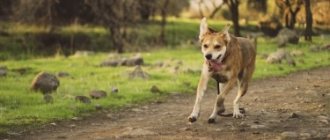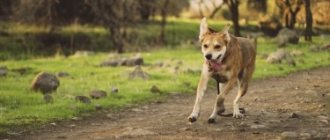I propose today to talk about how old age occurs in dogs. Unfortunately, none of us are immune from the aging of the body, just like our furry pets. After all, this is a natural biological process of restructuring the body. It cannot be prevented. You can only try to extend the life of your dog, making it happier and better.
Until recently, I didn’t even think about this question, until they openly hinted at it to me. It was like this... One day, we went to a hardware store to buy all sorts of construction and repair stuff. As usual, our favorite mustachioed “foreman” was with us.
Rushing with a cart past the racks with tiles and laminate, I suddenly heard: “Yes, this is the old Jack Russell...”. I would have just run past, not in any way connecting the phrase I heard with my Jack. But since there were no other terriers within a radius of ten meters, I realized that this statement was addressed specifically to us... Of course, I could not pass by. How is it that my little Juzik, my big-booted tomboy who runs like a bullet, tirelessly splashes in the sea, gallops like a young goat and will give odds to any young dog, was called old! He's only 8 years old!
Posted by Jack Russell Terrier (@jacki.dog) Feb 8, 2022 at 3:00 PST
“Why did you think he was old?” – I asked. “Well, of course,” they answered me. “His muzzle is already gray!”
And then I started thinking and began to analyze. But it’s true that, in addition to external signs, Dzhekusik also began to show changes in behavior. From time to time he begins to grumble if he suddenly disturbs the “royal person.” On walks he is no longer very interested in other dogs; he prefers to spend time with us. He already knows everything and understands it not even at a glance, but at a glance.
Gray hairs on the face, an intelligent and reasonable look. Sometimes it seems that he’s about to start talking to me, telling me how he lives, what he doesn’t like, and what he loves most... How quickly these 8 years have flown by...
But just “yesterday” I brought this little shilopop home, and, running out of the carrier, he began to run around like mad, knocking over all the corners and flowers...
We can say that our Jack was lucky. He is very rarely left alone. He is with us always and everywhere. But, peering at his already gray-haired, matured pug, you still begin to understand how little time we devote to him. We chase him away when we have no time, but he sniffles annoyingly and asks to play ball with him: “Don’t bother, Jack, it’s not up to you, we’ll finish the repairs and play...”.
But after some 3-5 years, perhaps it will be difficult for him to run after the ball, he will not rush to swim as soon as he smells the water...
So at what age does old age begin in dogs? What symptoms may indicate that a dog is aging? How to take care of an older pet? And what needs to be done to ensure that even in adulthood the four-legged dog remains vigorous and healthy?
At what age does a dog get old?
The lifespan of pets is much shorter than the lifespan of humans. The average lifespan of a dog is 10-15 years. There are cases where four-legged animals lived up to 20 years. It has been revealed that life expectancy directly depends on the size of the animal. The smaller the dog, the longer it lives, and the later it shows signs of aging.
Here are the approximate statistics of the so-called “average age” and life expectancy for dogs of different breeds:
- The average age for small breed dogs is 10 years. Life expectancy is 15-17 years.
- The average age for medium breed dogs is 8 years. Life expectancy is 11-14 years.
- The average age for large breed dogs is 6 years. Life expectancy is 8-10 years.
But all these numbers are individual for each pet. The rate of aging depends on many factors: conditions of detention, environment, genetic predisposition.
Empirically, a comparative table was compiled, from which you can determine the age of the dog by human standards. Thanks to this data, you can understand how your pet feels at a certain age stage.
Signs of aging in dogs
You need to be extremely careful when your dog enters the so-called “middle age”. Sometimes you may not notice the symptoms of a serious illness, considering them signs of aging. There are external and internal signs. As a rule, they become noticeable by the age of 6-8 years:
- An aging animal exhibits obvious changes in behavior: the dog becomes grouchy and “grumbles” if disturbed.
- Gray hair is visible on the face and head.
- The condition of the coat deteriorates. Bald spots may appear on the limbs, sternum and croup area. Shedding time increases.
- The body becomes less elastic and toned. There is a “sagging” of the back and abdomen.
- After 8-9 years, teeth acquire a yellowish tint, begin to wear down, become loose and fall out.
- Visual acuity decreases, and cataracts may develop.
- An older animal may develop partial deafness. Many dog owners perceive this behavior as unwillingness to obey. But you shouldn’t scold your four-legged dog if it doesn’t immediately respond to commands during walks. Perhaps you just need to have your aging pet's hearing tested.
- Temperament changes. The dog becomes difficult to rise, the former enthusiasm and energy disappears. Games are increasingly giving way to sleep. During walks, the animal refuses active entertainment. He is no longer interested in new acquaintances. He prefers to lie away from people and animals.
- An older pet's movements are slower and more leisurely. The gait is more unsteady, involuntary muscle spasms and loss of coordination may be observed. The dog can no longer easily climb the steps; each step is given to him with great difficulty.
- Sexual desire decreases.
- Another sure sign of aging dogs is a decrease in appetite. The dog may refuse food from time to time or not eat the usual portion. The fact is that with age, metabolism slows down. The four-legged animal becomes less active, and, as a result, the body’s energy need decreases. You should not force your dog to eat or try to force-feed it.
- Taste preferences may change with age.
- Very often you can find overfed, to put it mildly, well-fed older animals on the street. This is explained by the fact that owners of older dogs do not take into account the fact that the pet is no longer young, and continue to feed it according to the usual pattern.
- For the same reason, older animals may experience belching, hiccups, metabolism, and bloating.
- Often, older pets experience a frequent urge to urinate and uncontrollable bowel movements. At the same time, if a pet asks to go for a walk, he may not endure it and suddenly relieve himself at home or in the entrance.
It is strictly FORBIDDEN to scold the dog for this. An elderly pet requires more attention and indulgence than a small puppy.
- In addition, aging dogs may have unstable stools (diarrhea, constipation), and, as a result, clogged anal glands and painful bowel movements.
Slowing down the transit of food through the intestines
In older dogs, the transit of food through the digestive tract slows down. This is due to a decrease in intestinal muscle tone and a decrease in the production of acids that help break down food. In such cases, dogs sometimes experience alternating episodes of constipation and diarrhea. These problems can be controlled with a specially formulated diet.
The intestines, like the entire body, begin to work less efficiently. The efficiency of feed digestion is slightly reduced, and nutrient absorption is impaired; the animal needs more time to adapt to the change in diet. A high-quality, easily digestible diet will help minimize such manifestations.
Age-related problems and diseases
As dogs age, chronic diseases can worsen. It is often difficult for owners to recognize such diseases, mistaking their signs for senile symptoms. If you make the correct diagnosis in time and start treatment, you can extend your pet’s life by several years.
Older animals are most susceptible to the following diseases.
Joint diseases, muscle weakness (especially in large breeds)
Heart disease, heart failure. As a rule, this disease begins to appear in dogs over 5 years of age. Symptoms of the disease: heavy breathing, shortness of breath, weakness during physical activity, sometimes swelling of the paws, blue discoloration of the mucous membrane of the mouth. No matter how you are in a hurry, do not pull the dog by the leash, do not rush the elderly dog. Let him rest, take a breath. Be respectful of his age-related problems.
Kidney diseases
The kidneys filter and remove toxic substances and maintain water-salt balance. Experts believe that after 8 years, every dog suffers from kidney failure. But, unfortunately, serious symptoms of this disease may not appear until 60-80% of the kidneys stop functioning. Diagnosis is made only by blood and urine tests. The first symptom that should alert the owner is that the dog drinks more and asks to go to the toilet more often.
Diseases of the liver and gastrointestinal tract
With age, digestive problems, disruption of the liver and gastrointestinal tract may appear. The first symptoms of liver disease are loss of appetite and lethargy. In cases of more advanced liver disease, jaundice, vomiting, increased thirst and frequent urination, diarrhea or constipation appear.
For liver and gastrointestinal diseases, the most reliable remedy is an individual diet. Most likely, you will have to “place” a pet on it for the rest of its life. No matter how piteously the little tail looks at you, no matter how it begs and loves a piece of fatty meat or a bone, you will have to take all your will into your fist and not give in to this pleading look. The stricter you are in this matter, the more years of healthy life you will give your four-legged friend.
Problems with urination
Problems with urination are extremely painful for both the dog and its owner. Such problems can be a consequence of inflammatory processes in the bladder and kidneys. The animal cannot tolerate it and urinates involuntarily, often even in its sleep. Under no circumstances should you scold an elderly pet for this. The dog is well aware that he is doing wrong, but he cannot do anything.
Don't make your pet feel guilty. All his life he served you faithfully, all his life he did everything you wanted, all his life he endured your whims and bad mood. So tolerate this senile weakness of his, take pity on him, show him that in spite of everything, you still love him very much. And he doesn’t need more...
The opposite picture is observed when the animal has kidney stones. The dog cannot go to the toilet. Urination is rare and extremely painful, sometimes with blood. In this case, you should not torture the dog. It is imperative to show the animal to a specialist.
Allergy
As dogs age, their metabolism slows down. The dog becomes more vulnerable to harmful factors and harmful substances. Some animals may experience allergic reactions and itching. The dog begins to itch and hair falls out. Scratching causes wounds and bald spots on the skin. All this is very painful for a four-legged animal. It is useless to treat the consequences (wounds and scratches). First of all, you need to find out the cause of the allergy, and only then begin treatment.
Dental problems
Very often, old dogs' teeth begin to deteriorate. Grinding of teeth, caries, tartar - these are the main problems that can affect the animal’s jaw apparatus. Bad teeth have a bad effect on your pet’s well-being and health. The dog refuses to eat because every meal causes unbearable pain. Refusal to eat can lead to serious inflammatory processes and diseases of the gastrointestinal tract.
You need to regularly inspect your dog's mouth. Diseased and carious teeth are products of decay of the body. It is best to remove such teeth. Watch out for the formation of plaque and tartar. Carry out hygiene procedures regularly. Tartar formation can also lead to inflammation and tooth loss.
Hearing loss
Pets often lose their hearing as they age. On a walk it is very difficult to shout to them, but at home they do not hear when they are called to eat.
Decay of sexual function
Over the years, many animals' interest in the opposite sex fades, and in males this begins to manifest itself earlier. Bitches continue to be in heat until they are very old. Sometimes periods of hunting become longer than in youth. If in youth the hunting period was 3-4 days, then in old age it can last one or two weeks. The dog is ready to mate tirelessly, although such matings are already fruitless. Such an anomaly may indicate disease or inflammation of the uterus. In such cases, if the doctor recommends removal surgery, it may be worth agreeing, since growing tumors can threaten the dog’s health.
Oncological diseases
Unfortunately, as dogs age, they can develop cancer. It is often very difficult to recognize the disease in the early stages. The animal comes to the veterinary clinic when metastases appear. In this case, it is almost impossible to save the pet; the doctor can only make it feel better by prescribing supportive therapy. To reduce the risk of complications as a result of cancer, it is necessary to carefully examine and feel your elderly pet a couple of times a month. Any new growths or lumps are a reason for a visit to the veterinary clinic.
Increased body fat
As dogs age, they often become overweight. Fat deposits accumulate due to decreased muscle mass. With a large loss of muscle mass, the animal's mobility decreases, as a result it spends less energy. As a result, the dog's weight increases even more, and muscle mass decreases even more, and so on. It is extremely important to monitor the animal's physical condition to prevent weight gain and muscle loss. It is also important to manage any pain that may occur so that it does not interfere with the dog's ability to move actively.
How to take care of an elderly pet
Proper care will help avoid many health problems. But every owner of a four-legged dog should know that no amount of care, even the most competent care, will save the pet from old age. You need to understand that when a dog enters a period of maturity, it needs love, attention and care more than ever.
So how do you take care of an elderly pet? How to make sure that your four-legged dog remains vigorous and healthy for as long as possible? Here are a few rules that owners of older dogs must know:
- Many dogs remain active until the end and maintain an interest in the world around them and other dogs. But no matter how well your pet feels, still try to make fewer changes to the already established daily routine. The usual food, the usual daily routine. Any changes should be introduced gradually. Sudden changes lead to the animal becoming nervous and worried. This can be the impetus for rapid extinction.
- Some older pets become very jealous. If you decide to bring a young puppy into your family, be extremely careful. With its activity, the puppy can irritate the old man. A conflict may occur as a result of which the baby will suffer physically, and the elderly dog will suffer mentally. Before bringing a new puppy into your home, give the young and old dog a chance to socialize first. If everything goes well, feel free to get a puppy. But still, when a new, younger tail appears in the house, try to pay as much attention as possible to your elderly four-legged friend. This way your old man will not feel lonely and unnecessary.
- When walking, do not overload your aging pet with active games. If your dog gets tired easily and is breathing heavily, you may need to consult your veterinarian. At the same time, don’t let it sit and get fat. The leaner the pet, the less stress on the heart, bones and joints. Moderately well-fed dogs do not suffer from senile diseases. They have a much lower risk of gastrointestinal diseases.
- Feed your older dog a balanced, high-quality diet.
Since with age, the number of enzymes in the gastrointestinal tract that promote rapid digestion and better absorption of food decreases, after 8 years, veterinarians advise making adjustments and reviewing the usual diet.
I can confirm this fact from my own experience - Jack, indeed, began to consume much less food than a year and a half ago.
The usual portion should be reduced and given in several doses. The diet itself should consist of easily digestible and nutritious food. The food must be fresh. Do not get carried away with carbohydrates (porridge, bread). They stretch the stomach, and volvulus may occur. Eliminate all kinds of handouts from the table.
What else can you do:
- It is imperative to load the brain of an aging animal with regular mental puzzles and new exercises.
- If your dog freezes in damp and cold weather, reduce the time you walk and put your pet on a warm blanket or overalls.
- If it is difficult for your animal to move during a walk and he wants to sit or lie on the grass, do not pull on the leash and let the dog take a leisurely walk. Respect the wishes of an aging friend, because this may be his last walk in his life.
- Be sure to take your dog to the veterinarian at least once a year. Basic blood and urine tests will help the specialist detect possible signs of the disease in time.
- Regularly monitor the condition of your mouth and teeth.
- Feel and examine your pet more often, monitor the condition of the fur, ears and eyes.
- Vaccinate your four-legged dog annually. Some people think that an old pet does not need to be vaccinated. But this is a mistaken opinion. With age, the animal's immunity becomes weaker and the dog is more susceptible to disease. Vaccination will help strengthen the immune system and, in case of infection, make it easier to transfer the disease.
Cognitive load
“You can't teach an old dog new tricks,” says the saying. However, from the point of view of preventing cognitive dysfunction (in other words, senile “eccentricity” and even dementia), it is extremely useful for dogs, just like people, to “work with their heads” as much as possible. The processes that occur in the human brain in Alzheimer's disease and the processes that lead to cognitive dysfunction syndrome (CDS) in dogs are very similar: loss of neurons, atrophy of the cerebral cortex, and accumulation of beta-amyloid plaques in the brain.
To maintain “mental health,” learning new commands or complex tricks does not have to be the point of all time spent with your pet, although, of course, it is never too late to start practicing simple operant learning methods (positive reinforcement training).
Relatively simple measures are quite enough, for example, diversifying walking routes (at least deviating from the usual daily routes every week) - if it is difficult for the dog to cover distances sufficient for this, you can use a special stroller or baby stroller, a bicycle trailer, or drive a car.
A good exercise to keep your mind alert and stimulate your sensory nerve endings are exercises involving “nose work.” For example, a simple exercise with searching for a treat covered with a blanket; “Guess in which hand” (the dog shows with its nose or, in an advanced version of the exercise, with its paw, which fist holds the treat); “sniffing mats” (a high-pile rug in which a treat or toy is hidden), “cups/thimbles” (the dog finds a treat under one of 3 upside-down cups).
A variety of “interactive toys” are widely available in pet stores - many of them are better suited for strong and active dogs with a pronounced interest in food, but some are quite capable of an older dog - usually these are different versions of balls/tubes/toys with a cavity, from which the dog slowly extracts/gnaws/licks the treat hidden inside. For older dogs, it is preferable to use treats with a strong smell (wet food, liver, etc.)
You can hang a similar toy at the dog’s chest level (not higher!) to make the exercise more difficult without forcing your pet to jump high.
An interesting simple exercise from an experiment that studied cognitive dysfunction in dogs - while feeding, the dogs were offered two identical bowls at some distance from each other. A marker was placed next to the bowl in which the dog will receive food that day (this could be any visible object that is safe and neutral for the dog - for example, a cardboard cone, a plastic bottle, etc.). The skill of “recognizing the right bowl” stimulates memory and supports your pet’s brain function.
The general rule is that the more sensory information, the better. It is preferable to walk at a comfortable pace (for most dogs this is a moderately fast step) over rough terrain without serious obstacles - for example, a well-trodden path in the forest, when the dog is forced to step over roots, overcome small descents and ascents, and from time to time enters more loose/dense/rocky ones /grass-covered areas - in itself is an ideal exercise for an older dog (like Nordic walking for older people).
Stimulation of sensory nerve endings also includes the most banal stroking. Older dogs really need tactile contact - for them it is another guide to the world of sensations. Stroking, tapping, combing, fussing and hugging are also an important part of interaction with an older pet. If an old dog avoids tactile contact, first of all, this is a signal that it is necessary to consult a doctor and rule out the presence of pain of various natures, and secondly, a reason to look for alternative methods of tactile interaction that are acceptable and pleasant for the pet.
How to tell when a pet is dying
Unfortunately, the death of pets can occur suddenly. And the reason for this can be not only old age, but severe poisoning, injury or illness. Based on the changed habits and behavior, one can determine that this sad event will happen very soon:
- Rapid, intermittent breathing.
- Change in heart rate. The pulse of a dying animal becomes weak, thread-like, and in the last hours of life cannot be felt at all.
- Uncontrolled urination, defecation, vomiting. The animal is no longer able to control the body, the muscles are relaxed, and involuntary bowel movement occurs.
- Muscle weakness, lack of coordination of movements. The brain of a dying animal gradually dies and loses its neural connection with its muscles. Therefore, when the pet wants to get up, he fails to do so. He immediately falls on his side, crouches, falls and can no longer get up.
- You can often notice muscle spasms and cramps.
- Very old dogs experience muscle atrophy. The muscles are no longer firm and elastic, but feel like jelly to the touch. The animal cannot stand up at all, but only lies down.
- A few days before death, the dog may experience clouding or complete loss of consciousness.
- The skin loses its elasticity, becomes rough and hard. If you pull it back, it will no longer return to its place.
- A few days before death, the dog stops feeling tactile pain. At the same time, if a dog is sick with cancer, it is necessary to give it painkillers until the last minute, since the internal pain remains.
Activity decreases
While young dogs run briskly along the road while walking outside, older animals exhibit much less physical activity. They try to quickly relieve themselves and return home quickly, looking lost. It is easier for older dogs to just sit or lie next to a bench.
It is almost impossible for an old animal to force him to bring a stick or follow a command. At home, it prefers to sleep long and often rather than perform any actions.
To euthanize or not to euthanize a dog
Sometimes, when a pet is suffering from an incurable disease and even the best treatment does not produce any results and the animal is in unbearable pain, the veterinarian may suggest euthanasia. As a rule, such a solution is offered for incurable cancer, paralysis, and injuries incompatible with life.
To euthanize or not to euthanize a beloved pet is up to the owner to decide. But, in some cases, this is the only and most humane method. It’s better to quickly and painlessly help your beloved ponytail than to watch his unbearable, painful torment.
Yes, it is very difficult to decide to take such a step. It's hard to imagine that the sound of your favorite claws won't wake you up early in the morning. No one will wake you up by licking your face with a wet tongue. No one will run to the door, bursting into ringing barks, when they hear footsteps outside the door. No one will greet you joyfully from work and pester you to play with him.
If you realize that there is no other way out, be with your beloved friend until the very end. Do not abandon him in the last seconds of his life, do not leave him in the hands of strangers. Place your hand against the body of your furry loved one. Whisper in his ear how good he is. Even if he can no longer see that you are nearby, he will definitely feel it. It is important to him that you are nearby.
Why does a dog run away from home before dying?
There is an opinion that dogs and cats sense their approaching death and leave the house before they die. Why does this sometimes happen, because the dog is so attached to its owner that it literally follows on his heels all its life. There are several options to explain this phenomenon:
- Some believe that the animal senses the emotional state and anxiety of the owner, and in order not to disturb him, they try to leave. This is an erroneous judgment. Yes, many dogs sense the emotional state of a person very subtly. But for an animal, life and death are two identical natural states. You need to have human consciousness to leave home.
- Most biologists are of the opinion that a dog leaving home before its approaching death is explained by natural instincts, such as the departure of an old wolf from the pack.
Wolves are very loyal to their pack. Exhausted, the old wolf feels weak, he feels that he can no longer keep up with other relatives and, in order not to be a burden and to protect the young from attacks by larger predators, he leaves the pack. In addition, the old organism is a product of decay. It smells bad, and this smell can also attract other predators. Having strayed from the pack, the old wolf will most likely be killed, which means that death will be quick and painless.
Some dogs become clouded in their last days of life. Skills instilled in the process of communicating with a person are forgotten, and natural instincts, on the contrary, become more acute. This is the reason why a dog can leave home, even if it is very devoted to its owner.
Do not condemn your old pet to suffering in the last days of his life. Don't let him off the leash while you're walking so that he doesn't accidentally run away. Try to surround him with care and warmth so that he feels comfortable.
Links[edit]
- "Dog years to human years conversion". Archived from the original on 2013-12-14. Retrieved July 7, 2011.
- [ https://pets.webmd.com/dogs/how-to-calculate-your-dogs-age
- Dog years to human years calculator
- Wang, Tina; Ma, Jianzhu; Hogan, Andrew N.; Fong, Samson; Licon, Catherine; Tsui, Brian; Kreisberg, Jason F.; Adams, Peter D.; Karvounis, Ann-Ruxandra; Bannasch, Danika L.; Ostrander, Elaine A. (07/02/2020). "Quantitative conversion of aging from dog to human by conserved DNA methylome remodeling". Cellular systems
.
0
(2): 176–185.e6. DOI: 10.1016/j.cels.2020.06.006. ISSN 2405-4712. PMC 7484147. PMID 32619550. - Spadafori, Gina (1996). Dogs for dummies
. IDG Books. ISBN 1-56884-861-7 - Siegel, Mordecai (ed.; 1995). UC Davis School of Veterinary Medicine Book on Dogs
; Chapter 5 "Geriatrics" Aldrich, Janet. Harper Collins. ISBN 0-06-270136-3. - ↑
World's Oldest Dog Dies, Beaver County Times, March 13, 1984. Retrieved May 9, 2011. - ^ a b Lee, P. (2011). Longevity of the Australian Cattle Dog: Results of a Study of 100 Dogs. ACD Spotlight, Vol. 4, Issue 1, Spring 2011, pp. 96–105. https://www.acdspotlight.com/
- McAloney, California; Silverstein, K.A.; Modiano, J.F.; Bagchi, A (2014). "Polymorphisms in the telomerase reverse transcriptase (TERT) gene in four dog breeds selected for differences in lifespan and cancer susceptibility". BMC Vet Res
.
10
: 20. DOI: 10.1186/1746-6148-10-20. PMC 3904191. PMID 24423165. - Dog Aging Project
- ^ abc Michell AR (November 1999). "Longevity of British dog breeds and its relationship with sex, size, cardiovascular factors and disease." Vet. Rec
.
145
(22):625–9. DOI: 10.1136/vr.145.22.625. PMID 10619607. S2CID 34557345. - A dog that eats vegetables lives to a ripe old age—29 years; Also: Who is the oldest dog in the world; Archived 1.8 years later on February 5, 2016, at the Wayback Machine.
- "Bramble's Oldest Dog Died Yesterday - HighBeam Research Search Results". Archived from the original on 2013-01-03.
- Fickling, David (11 July 2004). "'Old' dog heads for the 27th birthday". World News. The keeper
. Retrieved November 30, 2013. - Prostate carcinoma in dogs: epidemiological evidence of increased risk in neutered dogs
, Teske E, Naan EC, van Dijk EM, Van Garderen E, Schalken JA, Department of Companion Animal Clinical Sciences, Utrecht University, The Netherlands. - "A Population-Based Study of Neutering Status as a Risk Factor for Canine Prostate Cancer" Bryan JN, Keeler MR, Henry SJ .
Etc. , Prostate gland. 2007, August 1; 67 (11): 1174–81). - O'Neill, CEO; Church, DB; McGreevy, Policeman; Thomson, PC; Broadbelt, D. C. (2013). "Longevity and Mortality of Domestic Dogs in England" (PDF). Veterinary Journal
.
198
(3):638–43. DOI: 10.1016/j.tvjl.2013.09.020. PMID 24206631. - "Dog Owner's Guide: Old Dog".
- PetPlace.com. "What to Expect Based on Your Dog's Age".
- PetPlace.com. "Questions about older dogs".
- "Dietary Protein for Dogs and Cats - The Importance of Digestible Protein". November 8, 2016. Retrieved November 22, 2022.
- Churchill, Julia A (2015). "Nutrition for Older Dogs: New Tips for Feeding Older Dogs." Brief description of the clinician
. - ^ ab "Chondroitin Sulfate and Glucosamine Supplements for Osteoarthritis". Retrieved November 22, 2022.
- Roush, James K.; Cross, Alan R.; Renberg, Walter C.; Dodd, Chadwick E.; Sixby, Christine A.; Fritsch, Dale A.; Allen, Timothy A.; Jewell, Dennis E.; Richardson, Daniel S. (2010). "Evaluating the effects of omega-3 fish oil fatty acid supplementation on weight bearing in dogs with osteoarthritis." Journal of the American Veterinary Medical Association
.
236
(1):67–73. DOI: 10.2460/javma.236.1.67. PMID 20043801. - "Calcium Supplements". vca_corporate
. Retrieved November 22, 2022. - "Benefits of Beet Pulp in Pet Food". www.peteducation.com
. Retrieved November 22, 2022. - "Common Pet Food Ingredients" (PDF). Veterinary clinic Skaer
. Retrieved November 22, 2022. - Swanson, K. S.; Grieshop, C. M.; Flickinger, E. A.; Bauer, L.L.; Healy, HP.; Dawson K.A.; Merchen NR; Fahey G.G. Jr. (May 2002). "Additional fructooligosaccharides, mannanoligosaccharides, influence immune function, ileal and whole-tract nutrient digestibility, microbial populations, and protein catabolite concentrations in the canine colon". Journal of Nutrition
.
132
(5):980–989. DOI: 10.1093/JN/132.5.980. PMID 11983825. - Roudebush, Philip; Zieker, Stephen S.; Cotman, Carl W.; Milgram, Norton W.; Muggenburg, Bruce A.; Head, Elizabeth (2005-09-01). "Nutritional Management of Brain Aging in Dogs." Journal of the American Veterinary Medical Association
.
227
(5):722–728. DOI: 10.2460/javma.2005.227.722. ISSN 0003-1488. PMID 16178393. - Wander, R. C.; Hall, J.A.; Gradin, J.L.; Shower; Jewell, D. E. (June 1997). "The ratio of dietary (n-6) to (n-3) fatty acids influences immune system function, eicosanoid metabolism, lipid peroxidation, and vitamin E status in older dogs". Journal of Nutrition
.
127
(6):1198–1205. DOI: 10.1093/JN/127.6.1198. PMID 9187636.











